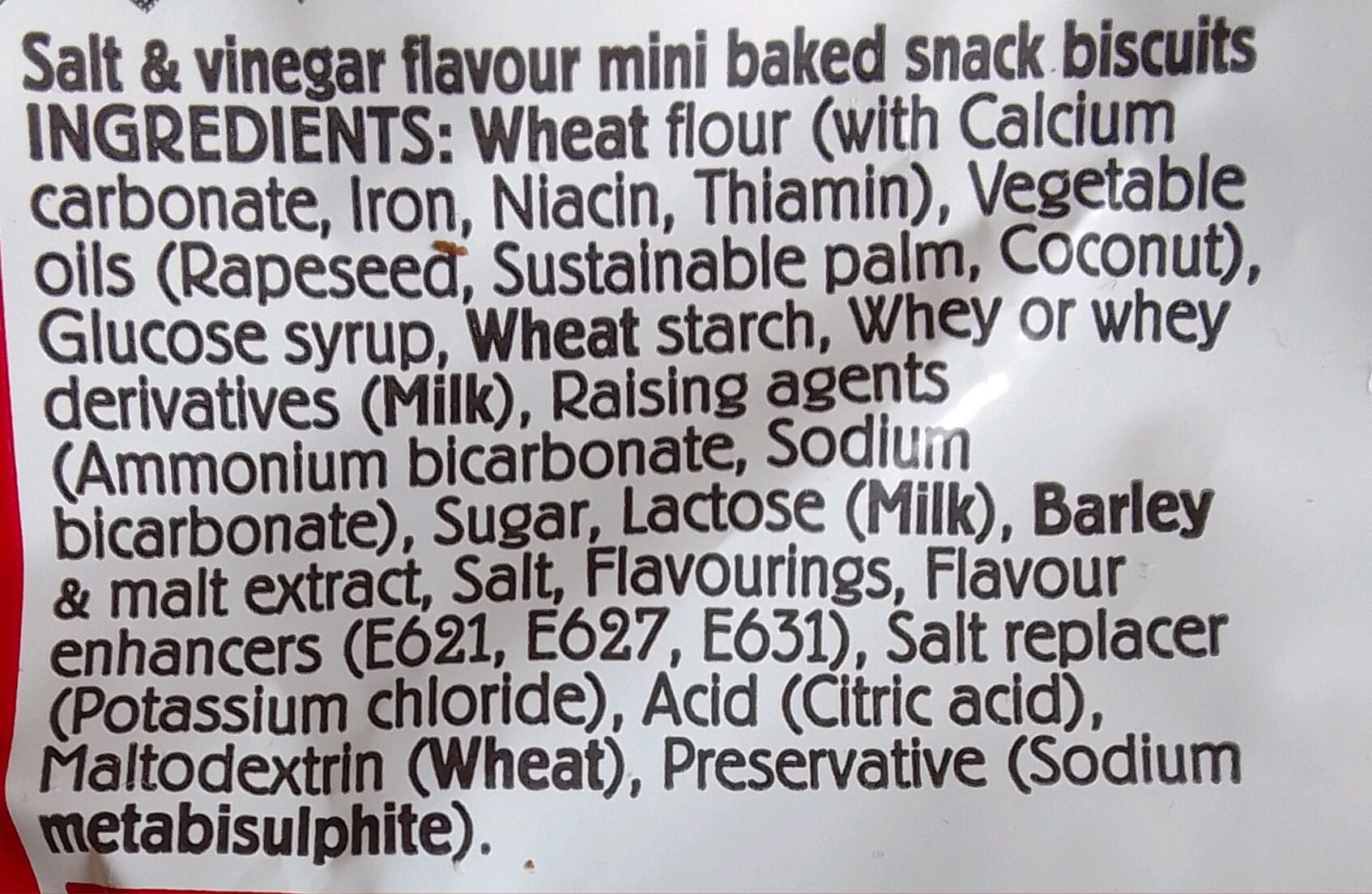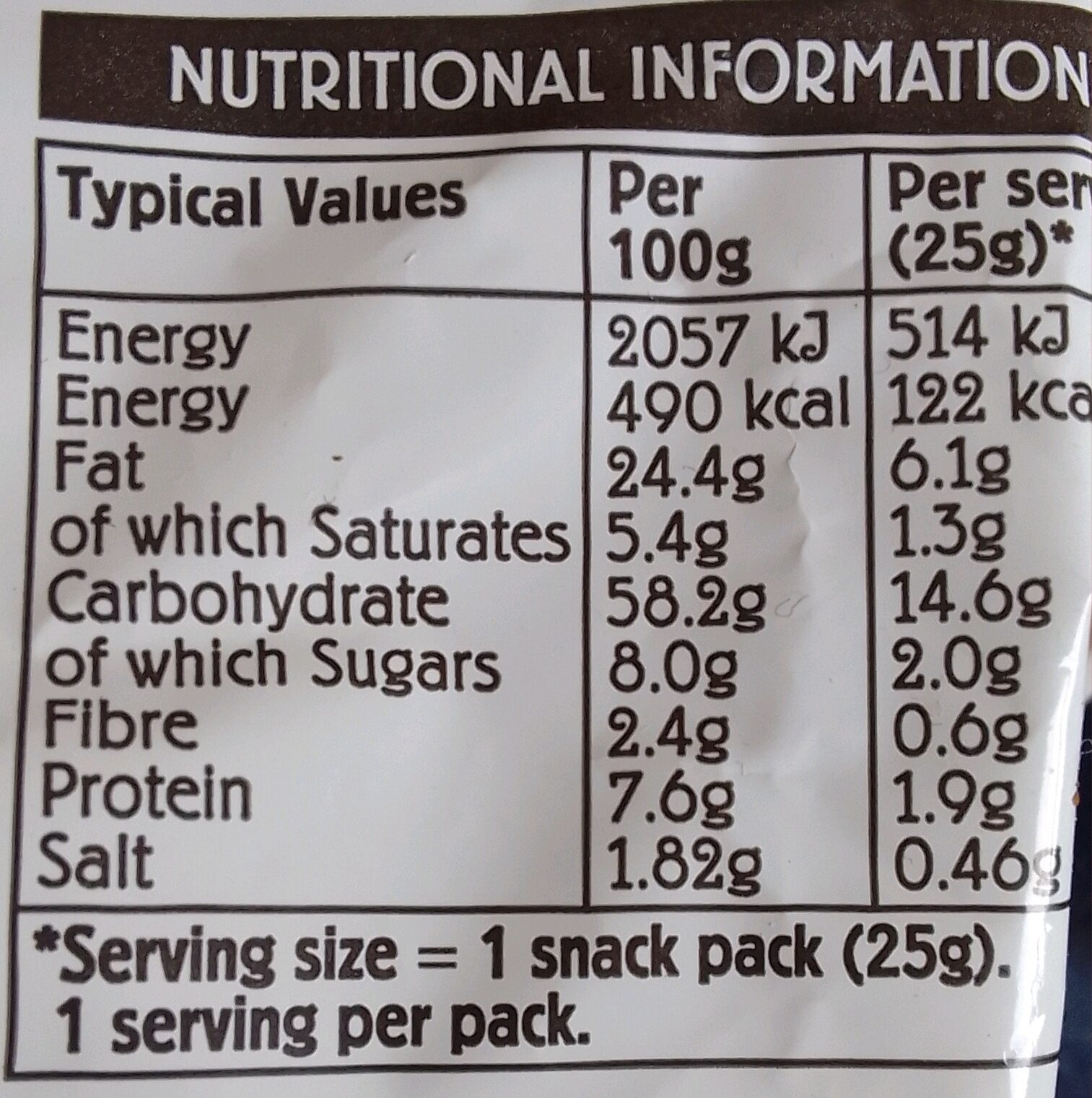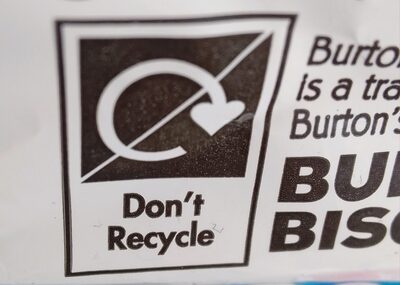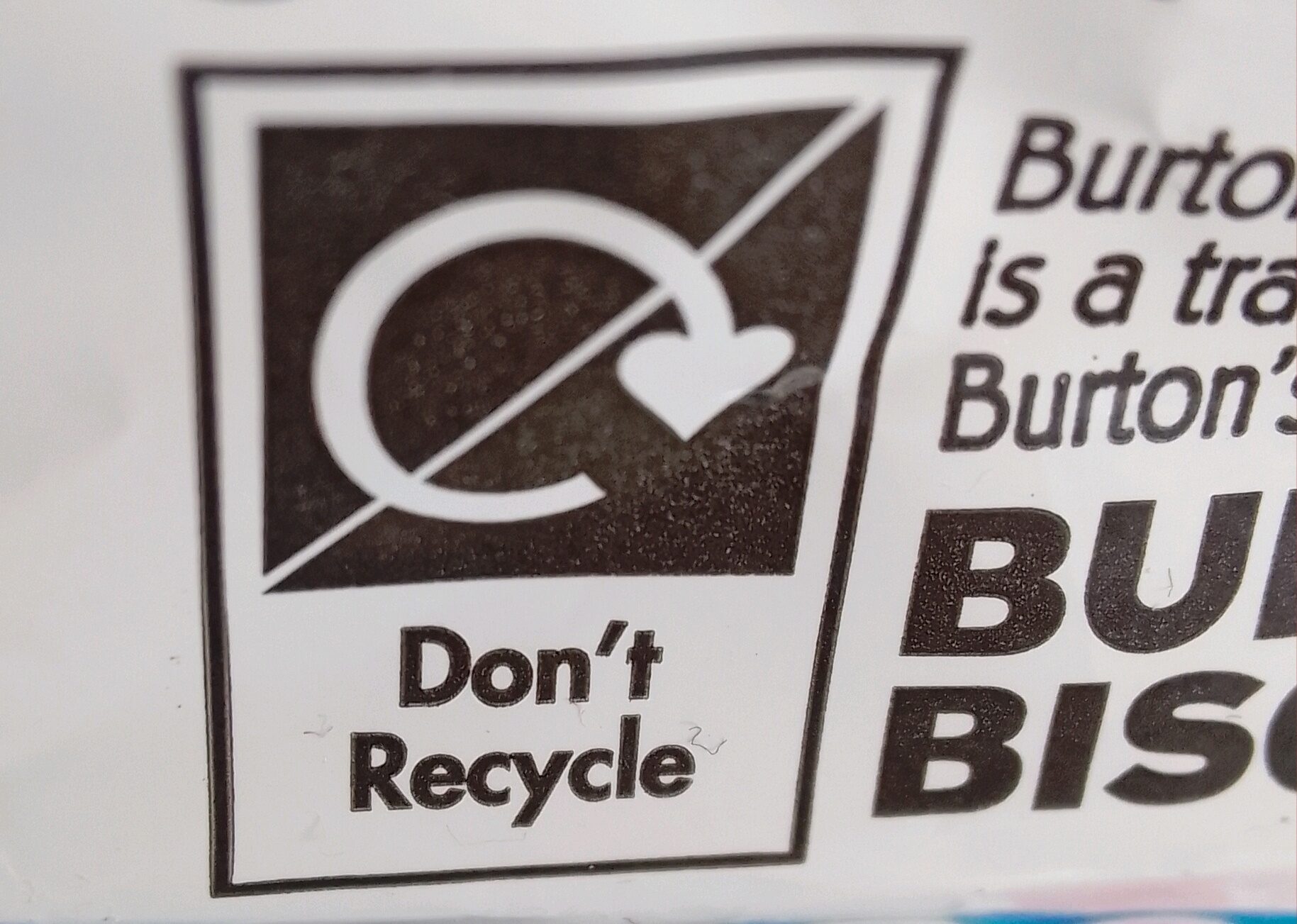Help us make food transparency the norm!
As a non-profit organization, we depend on your donations to continue informing consumers around the world about what they eat.
The food revolution starts with you!
Burton's Fish 'N' Chips - 25g
Burton's Fish 'N' Chips - 25g
This product page is not complete. You can help to complete it by editing it and adding more data from the photos we have, or by taking more photos using the app for Android or iPhone/iPad. Thank you!
×
Barcode: 0072417154874 (EAN / EAN-13) 072417154874 (UPC / UPC-A)
Quantity: 25g
Brandaí: Burton's
Catagóirí: en:Snacks, en:Sweet snacks, en:Biscuits and cakes, Briosca, en:Baked, en:Baked biscuits
Labels, certifications, awards: en:Vegetarian
Origin of ingredients: An Ríocht Aontaithe
Siopaí: Iceland
Country: Poblacht na hÉireann, An Ríocht Aontaithe
Matching with your preferences
Health
Comhábhair
-
34 ingredients
: wheat flour (with calcium ca bonate, iron, niacin, thiamin), vegetable oils (rapeseed, sustainable palm, coconut), glucose syrup, wheat starch, whey or whey derivatives (milk), raising agents (ammonium bicarbonate, sodium bicarbonate), sugar, lactose (milk), barley & malt extract, salt, flavourings, flavour enhancers (e621, e627, e631), salt replacer potassium chloride), acid (citric acid), maltodextrin (wheat), preservative (sodium metabisulphite). allergy advice for allergens, including cereals containing gluten, see ingredients in bold. may also contain nuts. ✔ no artificial colours no artificial sweeteners non gm ingredients ✓ no hydrogenated fatsHailléirginí: Glútan, BainneTraces: Cnónna
Food processing
-
Ultra processed foods
Elements that indicate the product is in the en:4 - Ultra processed food and drink products group:
- Additive: E621 - Glútamáit aonsóidiam
- Additive: E627
- Additive: E631
- Comhábhar: Méadaitheoir blais
- Comhábhar: Flavouring
- Comhábhar: Glúcós
- Comhábhar: Glucose syrup
- Comhábhar: Lachtós
- Comhábhar: Maltodextrin
Food products are classified into 4 groups according to their degree of processing:
- Unprocessed or minimally processed foods
- Processed culinary ingredients
- Processed foods
- Ultra processed foods
The determination of the group is based on the category of the product and on the ingredients it contains.
Additives
-
E223
Sodium metabisulfite: Sodium metabisulfite or sodium pyrosulfite -IUPAC spelling; Br. E. sodium metabisulphite or sodium pyrosulphite- is an inorganic compound of chemical formula Na2S2O5. The substance is sometimes referred to as disodium metabisulfite. It is used as a disinfectant, antioxidant, and preservative agent.Source: Wikipedia (An Béarla)
-
E330 - Aigéad citreach
Aigéad citreach: Aigéad carbocsaileach é an t-aigéad citreach HOOCCH2CHOH-COOH-CH2COOH. Tá sé le fáil go nádúrtha sa líomóid, san oráiste agus sna torthaí citris eile. Leasaitheach nádúrtha atá ann, agus cuirtear leis an mbia agus leis an deoch go minic é. Tá ról tábhachtach ag an aigéad citreach i meitibileacht na neach beo go léir, nó tá a leithéid ann agus timthriall an aigéid chitrigh. Timthriall d'imoibrithe ceimiceacha atá i gceist ina bhfuil an t-aigéad citreach ar ceann de na céimeanna, agus is cuid den ríospráid cheallach é - is é sin, an dóigh a mbíonn na cealla ag "análú" agus ag claochlú -ag dó- na saille agus na gcarbaihiodráití go dé-ocsaíd charbóin.Source: Wikipedia
-
E500
Sodium carbonate: Sodium carbonate, Na2CO3, -also known as washing soda, soda ash and soda crystals, and in the monohydrate form as crystal carbonate- is the water-soluble sodium salt of carbonic acid. It most commonly occurs as a crystalline decahydrate, which readily effloresces to form a white powder, the monohydrate. Pure sodium carbonate is a white, odorless powder that is hygroscopic -absorbs moisture from the air-. It has a strongly alkaline taste, and forms a moderately basic solution in water. Sodium carbonate is well known domestically for its everyday use as a water softener. Historically it was extracted from the ashes of plants growing in sodium-rich soils, such as vegetation from the Middle East, kelp from Scotland and seaweed from Spain. Because the ashes of these sodium-rich plants were noticeably different from ashes of timber -used to create potash-, they became known as "soda ash". It is synthetically produced in large quantities from salt -sodium chloride- and limestone by a method known as the Solvay process. The manufacture of glass is one of the most important uses of sodium carbonate. Sodium carbonate acts as a flux for silica, lowering the melting point of the mixture to something achievable without special materials. This "soda glass" is mildly water-soluble, so some calcium carbonate is added to the melt mixture to make the glass produced insoluble. This type of glass is known as soda lime glass: "soda" for the sodium carbonate and "lime" for the calcium carbonate. Soda lime glass has been the most common form of glass for centuries. Sodium carbonate is also used as a relatively strong base in various settings. For example, it is used as a pH regulator to maintain stable alkaline conditions necessary for the action of the majority of photographic film developing agents. It acts as an alkali because when dissolved in water, it dissociates into the weak acid: carbonic acid and the strong alkali: sodium hydroxide. This gives sodium carbonate in solution the ability to attack metals such as aluminium with the release of hydrogen gas.It is a common additive in swimming pools used to raise the pH which can be lowered by chlorine tablets and other additives which contain acids. In cooking, it is sometimes used in place of sodium hydroxide for lyeing, especially with German pretzels and lye rolls. These dishes are treated with a solution of an alkaline substance to change the pH of the surface of the food and improve browning. In taxidermy, sodium carbonate added to boiling water will remove flesh from the bones of animal carcasses for trophy mounting or educational display. In chemistry, it is often used as an electrolyte. Electrolytes are usually salt-based, and sodium carbonate acts as a very good conductor in the process of electrolysis. In addition, unlike chloride ions, which form chlorine gas, carbonate ions are not corrosive to the anodes. It is also used as a primary standard for acid-base titrations because it is solid and air-stable, making it easy to weigh accurately.Source: Wikipedia (An Béarla)
-
E500ii
Sodium carbonate: Sodium carbonate, Na2CO3, -also known as washing soda, soda ash and soda crystals, and in the monohydrate form as crystal carbonate- is the water-soluble sodium salt of carbonic acid. It most commonly occurs as a crystalline decahydrate, which readily effloresces to form a white powder, the monohydrate. Pure sodium carbonate is a white, odorless powder that is hygroscopic -absorbs moisture from the air-. It has a strongly alkaline taste, and forms a moderately basic solution in water. Sodium carbonate is well known domestically for its everyday use as a water softener. Historically it was extracted from the ashes of plants growing in sodium-rich soils, such as vegetation from the Middle East, kelp from Scotland and seaweed from Spain. Because the ashes of these sodium-rich plants were noticeably different from ashes of timber -used to create potash-, they became known as "soda ash". It is synthetically produced in large quantities from salt -sodium chloride- and limestone by a method known as the Solvay process. The manufacture of glass is one of the most important uses of sodium carbonate. Sodium carbonate acts as a flux for silica, lowering the melting point of the mixture to something achievable without special materials. This "soda glass" is mildly water-soluble, so some calcium carbonate is added to the melt mixture to make the glass produced insoluble. This type of glass is known as soda lime glass: "soda" for the sodium carbonate and "lime" for the calcium carbonate. Soda lime glass has been the most common form of glass for centuries. Sodium carbonate is also used as a relatively strong base in various settings. For example, it is used as a pH regulator to maintain stable alkaline conditions necessary for the action of the majority of photographic film developing agents. It acts as an alkali because when dissolved in water, it dissociates into the weak acid: carbonic acid and the strong alkali: sodium hydroxide. This gives sodium carbonate in solution the ability to attack metals such as aluminium with the release of hydrogen gas.It is a common additive in swimming pools used to raise the pH which can be lowered by chlorine tablets and other additives which contain acids. In cooking, it is sometimes used in place of sodium hydroxide for lyeing, especially with German pretzels and lye rolls. These dishes are treated with a solution of an alkaline substance to change the pH of the surface of the food and improve browning. In taxidermy, sodium carbonate added to boiling water will remove flesh from the bones of animal carcasses for trophy mounting or educational display. In chemistry, it is often used as an electrolyte. Electrolytes are usually salt-based, and sodium carbonate acts as a very good conductor in the process of electrolysis. In addition, unlike chloride ions, which form chlorine gas, carbonate ions are not corrosive to the anodes. It is also used as a primary standard for acid-base titrations because it is solid and air-stable, making it easy to weigh accurately.Source: Wikipedia (An Béarla)
-
E503
Ammonium carbonate: Ammonium carbonate is a salt with the chemical formula -NH4-2CO3. Since it readily degrades to gaseous ammonia and carbon dioxide upon heating, it is used as a leavening agent and also as smelling salt. It is also known as baker's ammonia and was a predecessor to the more modern leavening agents baking soda and baking powder. It is a component of what was formerly known as sal volatile and salt of hartshorn.Source: Wikipedia (An Béarla)
-
E503ii
Ammonium carbonate: Ammonium carbonate is a salt with the chemical formula -NH4-2CO3. Since it readily degrades to gaseous ammonia and carbon dioxide upon heating, it is used as a leavening agent and also as smelling salt. It is also known as baker's ammonia and was a predecessor to the more modern leavening agents baking soda and baking powder. It is a component of what was formerly known as sal volatile and salt of hartshorn.Source: Wikipedia (An Béarla)
-
E621 - Glútamáit aonsóidiam
Glútamáit aonsóidiam: Oibreán blaistithe a úsáidtear chun blas feola a fheabhsú -MSG i mBéarla-, a chuirtear le han-chuid bianna próiseáilte a bhfuil feoil nó úsc feola iontu. Bhíodh scanradh ann go gcuirfí an iomarca MSG sa chothú, mar shampla i mbéilí ó phroinntithe Síneacha. Ach asúitear í i bhfoirm aigéid ghlútamaigh sa cholainn, an t-aimínaigéad nádúrtha is flúirsí san imshruthú fola, agus b'fhíordheacair a thiúchan sa bhfuil a mhéadú le béile nó dhó. Glactar leis gurbh iarmhairt shíceasómatach é ‘siondróm an phroinntí Shínigh'. Mar sin féin, ní cheadaítear do dhéantúsóirí MSG é a chur i mbianna i gcomhair naíonán is leanaí.Source: Wikipedia
-
E627
Disodium guanylate: Disodium guanylate, also known as sodium 5'-guanylate and disodium 5'-guanylate, is a natural sodium salt of the flavor enhancing nucleotide guanosine monophosphate -GMP-. Disodium guanylate is a food additive with the E number E627. It is commonly used in conjunction with glutamic acid. As it is a fairly expensive additive, it is not used independently of glutamic acid; if disodium guanylate is present in a list of ingredients but MSG does not appear to be, it is likely that glutamic acid is provided as part of another ingredient such as a processed soy protein complex. It is often added to foods in conjunction with disodium inosinate; the combination is known as disodium 5'-ribonucleotides. Disodium guanylate is produced from dried seaweed and is often added to instant noodles, potato chips and other snacks, savory rice, tinned vegetables, cured meats, and packaged soup.Source: Wikipedia (An Béarla)
-
E631
Disodium inosinate: Disodium inosinate -E631- is the disodium salt of inosinic acid with the chemical formula C10H11N4Na2O8P. It is used as a food additive and often found in instant noodles, potato chips, and a variety of other snacks. Although it can be obtained from bacterial fermentation of sugars, it is often commercially prepared from animal sources.Source: Wikipedia (An Béarla)
Ingredients analysis
-
en:Palm oil
Ingredients that contain palm oil: Ola phailme
-
en:Non-vegan
Non-vegan ingredients: LachtósSome ingredients could not be recognized.
We need your help!
You can help us recognize more ingredients and better analyze the list of ingredients for this product and others:
- Edit this product page to correct spelling mistakes in the ingredients list, and/or to remove ingredients in other languages and sentences that are not related to the ingredients.
- Add new entries, synonyms or translations to our multilingual lists of ingredients, ingredient processing methods, and labels.
If you would like to help, join the #ingredients channel on our Slack discussion space and/or learn about ingredients analysis on our wiki. Thank you!
-
en:Vegetarian
No non-vegetarian ingredients detected
Unrecognized ingredients: en:with-calcium-ca-bonate, Iarann, Tiaimín, en:whey-and-whey-derivatives, en:salt-replacer-potassium-chloride, en:✔-no-artificial-colours-no-artificial-sweeteners-non-gm-ingredients-✓-no-hydrogenated-fatsSome ingredients could not be recognized.
We need your help!
You can help us recognize more ingredients and better analyze the list of ingredients for this product and others:
- Edit this product page to correct spelling mistakes in the ingredients list, and/or to remove ingredients in other languages and sentences that are not related to the ingredients.
- Add new entries, synonyms or translations to our multilingual lists of ingredients, ingredient processing methods, and labels.
If you would like to help, join the #ingredients channel on our Slack discussion space and/or learn about ingredients analysis on our wiki. Thank you!
-
Details of the analysis of the ingredients
We need your help!
Some ingredients could not be recognized.
We need your help!
You can help us recognize more ingredients and better analyze the list of ingredients for this product and others:
- Edit this product page to correct spelling mistakes in the ingredients list, and/or to remove ingredients in other languages and sentences that are not related to the ingredients.
- Add new entries, synonyms or translations to our multilingual lists of ingredients, ingredient processing methods, and labels.
If you would like to help, join the #ingredients channel on our Slack discussion space and/or learn about ingredients analysis on our wiki. Thank you!
: wheat flour (with calcium ca bonate, iron, niacin, thiamin), vegetable oils (rapeseed, sustainable palm, coconut), glucose syrup, wheat starch, whey and whey derivatives, raising agents (ammonium bicarbonate, sodium bicarbonate), sugar, lactose, barley, malt extract, salt, flavourings, flavour enhancers (e621, e627, e631), salt replacer potassium chloride, acid (citric acid), maltodextrin (wheat), preservative (sodium metabisulphite), including cereals containing gluten, ✔ no artificial colours no artificial sweeteners non gm ingredients ✓ no hydrogenated fats- wheat flour -> en:wheat-flour - vegan: yes - vegetarian: yes - ciqual_proxy_food_code: 9410 - percent_min: 5.26315789473684 - percent_max: 100
- with calcium ca bonate -> en:with-calcium-ca-bonate - percent_min: 1.31578947368421 - percent_max: 100
- iron -> en:iron - percent_min: 0 - percent_max: 50
- niacin -> en:e375 - vegan: maybe - vegetarian: maybe - percent_min: 0 - percent_max: 33.3333333333333
- thiamin -> en:thiamin - percent_min: 0 - percent_max: 25
- vegetable oils -> en:vegetable-oil - vegan: yes - vegetarian: yes - from_palm_oil: maybe - percent_min: 0 - percent_max: 50
- rapeseed -> en:rapeseed - vegan: yes - vegetarian: yes - percent_min: 0 - percent_max: 50
- sustainable palm -> en:palm-oil - vegan: yes - vegetarian: yes - from_palm_oil: yes - ciqual_food_code: 16129 - percent_min: 0 - percent_max: 25
- coconut -> en:coconut - vegan: yes - vegetarian: yes - ciqual_proxy_food_code: 15006 - percent_min: 0 - percent_max: 16.6666666666667
- glucose syrup -> en:glucose-syrup - vegan: yes - vegetarian: yes - ciqual_proxy_food_code: 31016 - percent_min: 0 - percent_max: 33.3333333333333
- wheat starch -> en:wheat-starch - vegan: yes - vegetarian: yes - ciqual_proxy_food_code: 9510 - percent_min: 0 - percent_max: 25
- whey and whey derivatives -> en:whey-and-whey-derivatives - percent_min: 0 - percent_max: 20
- raising agents -> en:raising-agent - percent_min: 0 - percent_max: 16.6666666666667
- ammonium bicarbonate -> en:e503ii - vegan: yes - vegetarian: yes - percent_min: 0 - percent_max: 16.6666666666667
- sodium bicarbonate -> en:e500ii - vegan: yes - vegetarian: yes - percent_min: 0 - percent_max: 8.33333333333333
- sugar -> en:sugar - vegan: yes - vegetarian: yes - ciqual_proxy_food_code: 31016 - percent_min: 0 - percent_max: 8
- lactose -> en:lactose - vegan: no - vegetarian: yes - percent_min: 0 - percent_max: 8
- barley -> en:barley - vegan: yes - vegetarian: yes - percent_min: 0 - percent_max: 8
- malt extract -> en:malt-extract - vegan: yes - vegetarian: yes - percent_min: 0 - percent_max: 8
- salt -> en:salt - vegan: yes - vegetarian: yes - ciqual_food_code: 11058 - percent_min: 0 - percent_max: 1.82
- flavourings -> en:flavouring - vegan: maybe - vegetarian: maybe - percent_min: 0 - percent_max: 1.82
- flavour enhancers -> en:flavour-enhancer - percent_min: 0 - percent_max: 1.82
- e621 -> en:e621 - vegan: yes - vegetarian: yes - percent_min: 0 - percent_max: 1.82
- e627 -> en:e627 - vegan: maybe - vegetarian: maybe - percent_min: 0 - percent_max: 0.91
- e631 -> en:e631 - vegan: maybe - vegetarian: maybe - percent_min: 0 - percent_max: 0.606666666666667
- salt replacer potassium chloride -> en:salt-replacer-potassium-chloride - percent_min: 0 - percent_max: 1.82
- acid -> en:acid - percent_min: 0 - percent_max: 1.82
- citric acid -> en:e330 - vegan: yes - vegetarian: yes - percent_min: 0 - percent_max: 1.82
- maltodextrin -> en:maltodextrin - vegan: yes - vegetarian: yes - percent_min: 0 - percent_max: 1.82
- wheat -> en:wheat - vegan: yes - vegetarian: yes - ciqual_proxy_food_code: 9410 - percent_min: 0 - percent_max: 1.82
- preservative -> en:preservative - percent_min: 0 - percent_max: 1.82
- sodium metabisulphite -> en:e223 - vegan: yes - vegetarian: yes - percent_min: 0 - percent_max: 1.82
- including cereals containing gluten -> en:cereals-containing-gluten - vegan: yes - vegetarian: yes - percent_min: 0 - percent_max: 1.82
- ✔ no artificial colours no artificial sweeteners non gm ingredients ✓ no hydrogenated fats -> en:✔-no-artificial-colours-no-artificial-sweeteners-non-gm-ingredients-✓-no-hydrogenated-fats - percent_min: 0 - percent_max: 1.82
Nutrition
-
Poor nutritional quality
⚠ ️Warning: the amount of fruits, vegetables and nuts is not specified on the label, it was estimated from the list of ingredients: 17This product is not considered a beverage for the calculation of the Nutri-Score.
Positive points: 2
- Próitéiní: 4 / 5 (value: 7.6, rounded value: 7.6)
- Fiber: 2 / 5 (value: 2.4, rounded value: 2.4)
- Fruits, vegetables, nuts, and colza/walnut/olive oils: 0 / 5 (value: 17.7631578947368, rounded value: 17.8)
Negative points: 20
- Energy: 6 / 10 (value: 2057, rounded value: 2057)
- Siúcraí: 1 / 10 (value: 8, rounded value: 8)
- Saturated fat: 5 / 10 (value: 5.4, rounded value: 5.4)
- Sodium: 8 / 10 (value: 728, rounded value: 728)
The points for proteins are not counted because the negative points are greater or equal to 11.
Nutritional score: (20 - 2)
Nutri-Score:
-
Nutrient levels
-
Saill as high quantity (24.4%)
What you need to know- A high consumption of fat, especially saturated fats, can raise cholesterol, which increases the risk of heart diseases.
Recommendation: Limit the consumption of fat and saturated fat- Choose products with lower fat and saturated fat content.
-
SáSitheáin saill as high quantity (5.4%)
What you need to know- A high consumption of fat, especially saturated fats, can raise cholesterol, which increases the risk of heart diseases.
Recommendation: Limit the consumption of fat and saturated fat- Choose products with lower fat and saturated fat content.
-
Siúcraí as moderate quantity (8%)
What you need to know- A high consumption of sugar can cause weight gain and tooth decay. It also augments the risk of type 2 diabetes and cardio-vascular diseases.
Recommendation: Limit the consumption of sugar and sugary drinks- Sugary drinks (such as sodas, fruit beverages, and fruit juices and nectars) should be limited as much as possible (no more than 1 glass a day).
- Choose products with lower sugar content and reduce the consumption of products with added sugars.
-
Salann as high quantity (1.82%)
What you need to know- A high consumption of salt (or sodium) can cause raised blood pressure, which can increase the risk of heart disease and stroke.
- Many people who have high blood pressure do not know it, as there are often no symptoms.
- Most people consume too much salt (on average 9 to 12 grams per day), around twice the recommended maximum level of intake.
Recommendation: Limit the consumption of salt and salted food- Reduce the quantity of salt used when cooking, and don't salt again at the table.
- Limit the consumption of salty snacks and choose products with lower salt content.
-
-
Nutrition facts
Nutrition facts As sold
for 100 g / 100 mlCompared to: Briosca Fuinneamh 2,057 kj
(490 kcal)+7% Saill 24.4 g +20% SáSitheáin saill 5.4 g -47% Carbaihiodráit 58.2 g -5% Siúcraí 8 g -72% Snáithín 2.4 g -20% Próitéin 7.6 g +26% Salann 1.82 g +249% Fruits‚ vegetables‚ nuts and rapeseed‚ walnut and olive oils (estimate from ingredients list analysis) 17.763 %
Environment
-
Eco-Score B - Low environmental impact
The Eco-Score is an experimental score that summarizes the environmental impacts of food products.→ The Eco-Score was initially developped for France and it is being extended to other European countries. The Eco-Score formula is subject to change as it is regularly improved to make it more precise and better suited to each country.Life cycle analysis
-
Average impact of products of the same category: B (Score: 69/100)
Catagóir: Biscuit (cookie)
Catagóir: Biscuit (cookie)
- PEF environmental score: 0.35 (the lower the score, the lower the impact)
- including impact on climate change: 2.88 kg CO2 eq/kg of product
Stage Impact Agriculture
80.5 %Processing
11.8 %Packaging
3.1 %Transportation
3.2 %Distribution
1.4 %Consumption
0.0 %
Bonuses and maluses
-
Origins of ingredients with a low impact
Bonus: +17
Environmental policy: +5
Transportation: +12
Origin of the product and/or its ingredients % of ingredients Impact An Ríocht Aontaithe 100 %íseal
-
Ingredients that threatens species
Malus: -10
Contains palm oil
Tropical forests in Asia, Africa and Latin America are destroyed to create and expand oil palm tree plantations. The deforestation contributes to climate change, and it endangers species such as the orangutan, the pigmy elephant and the Sumatran rhino.
-
Missing packaging information for this product
Malus: -15
⚠ ️ The information about the packaging of this product is not filled in.⚠ ️ For a more precise calculation of the Eco-Score, you can modify the product page and add them.
If you are the manufacturer of this product, you can send us the information with our free platform for producers.
Eco-Score for this product
-
Impact for this product: B (Score: 61/100)
Táirge: Burton's Fish 'N' Chips - 25g
Life cycle analysis score: 69
Sum of bonuses and maluses: -8
Final score: 61/100
-
Carbon footprint
-
Equal to driving 1.5 km in a petrol car
288 g CO² per 100g of product
The carbon emission figure comes from ADEME's Agribalyse database, for the category: Biscuit (cookie) (Source: ADEME Agribalyse Database)
Stage Impact Agriculture
82.9 %Processing
7.9 %Packaging
3.8 %Transportation
4.7 %Distribution
0.7 %Consumption
0.0 %
Packaging
-
Missing packaging information for this product
⚠ ️ The information about the packaging of this product is not filled in.Take a photo of the recycling information Take a photo of the recycling information
Transportation
-
Origins of ingredients
Origins of ingredients with a low impact
Origin of the product and/or its ingredients % of ingredients Impact An Ríocht Aontaithe 100 %íseal
Threatened species
-
Contains palm oil
Drives deforestation and threatens species such as the orangutan
Tropical forests in Asia, Africa and Latin America are destroyed to create and expand oil palm tree plantations. The deforestation contributes to climate change, and it endangers species such as the orangutan, the pigmy elephant and the Sumatran rhino.
Report a problem
-
Incomplete or incorrect information?
Category, labels, ingredients, allergens, nutritional information, photos etc.
If the information does not match the information on the packaging, please complete or correct it. Open Food Facts is a collaborative database, and every contribution is useful for all.
Data sources
Product added on ag openfoodfacts-contributors
Last edit of product page on ag bzets.
Product page also edited by inf.












